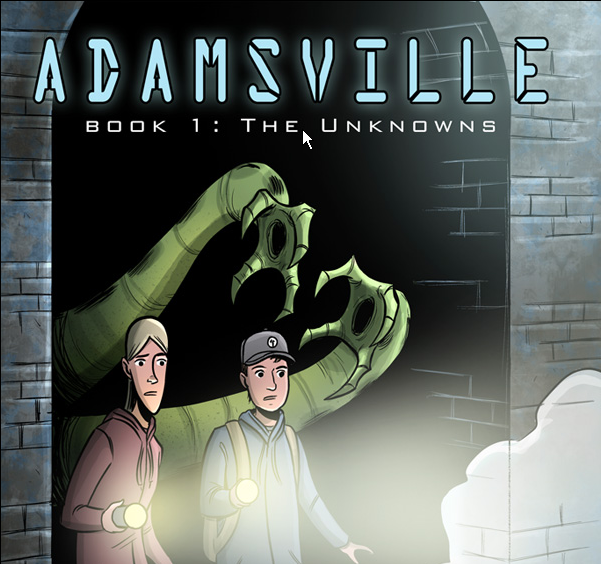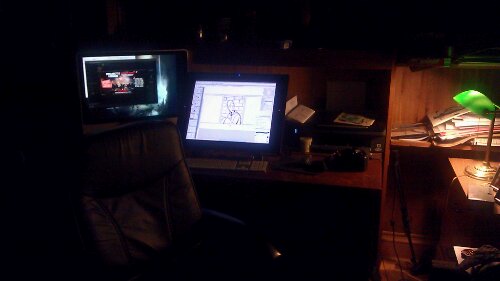While working a full time job, having a marriage and being a parent… Basically LIVING LIFE!
So last year I finished up work on my what is my second full length graphic novel, ADAMSVILLE: THE UNKNOWNS. I began the process of working on it in July 2011 and finished December 2012. It was 155 pages long, fully colored and by the time I was done, I was exhausted! Lol. I’ve spent the last five months searching for a publishing home for the project and I’m busy writing it’s sequels. But what I hoped I would share with everyone, is how I did it. I’m finding that a lot of people are amazed I was able to pull it off with so much other stuff going on and I figured explaining it might be of use to someone out there.
1.) Preparation –
When I started this project, I actually abandoned all webcomic models for how to make a book, favoring instead to treat my book as if a publisher were paying me an advance and asking to me to make a book and turn it in complete. So I spent a lot time reading how other artists did this.
I basically said, I want to know how the most successful people in this field make their books and then work within that frame work. Kazu Kibuishi’s blog has a great archive of blog posts about his process on Amulet book 1 and I highly recommend this for an inside look at how that amazing series is made. Doug TenNapel is another artist I have mentioned often and several of the videos he’s made are very helpful too. Like this one:
Once I had done some research, I felt the best thing for me to do was:
2.) Write The Entire Script-
All artists have their own process for getting a story done and some do very well in writing it as they go. That said, that’s very tough and to expect as a new creator to handle this well is sort of difficult. Those who have done it well, have been doing it for a long time. So I decided, I would write my entire book and do my very best to have as solid a story as possible. As I would later find, I had more rewriting to do, but in the end it came through as an advantage. It took me about a month and a half to get this book written and rewritten. In all fairness, I had written previous drafts of the book that gave me a solid foundation to begin from. I write my books in screenplay format, using the free program Celtx.
3.) Plan Your Work Load –
The next step was to go through my entire script and get a sense for how long it would be by doing early thumbnail break downs. I actually follow just about the same exact process as Doug TenNapel does in the video above, taking my script and breaking the written page down into panels and page breaks. What this allowed me to do, was before I had even started penciling of thumbnailing a page, I had a good sense of how long the book was going to be. At that time it was 138 pages. This was going into August 2011, and I was two months into the process.
Once I had everything broken down into pages I could start setting a deadline and workload for myself. Now, since I wasn’t making my book online, I wasn’t interested in maintaining a update schedule, as much as I was maintaining a production schedule. To accomplish this I began a pretty crude process of breaking my work load down into steps and then determining how many steps I had to accomplish per day to meet a deadline. A single page would have 5 steps for me (thumbnails, pencils, inks, color flats and colors/letter). Eventually I created a spreadsheet based on some awesome stuff Kazu shared in his Making Comics interview with Jason Brubaker. Once you input the data into the spreadsheet, it gave me a workflow that, if I maintained, I could use to stay on track. My initial goal was be done by September 2012.
The long and short of it is, know what your workload is, set a deadline and plan accordingly.
If you are interested in how I actually worked through a page, here is a post on that subject.
4.) Use Your Time Wisely… And You Will Never Sleep
A big chunk of my day, around 9 hours worth, is spent at an office job. I don’t work in the art field at all, but I wasn’t going to let that slow me down. I brought my comic work to work with me. There are certain parts of my process I have intentionally left away from the computer so that it can travel with me and I would make use of my breaks, lunches and any other appropriate down time to work on my book. So rather surf the web, I would try and do something that got me closer to a goal I had set for myself. You have a lot more free time than you think, you just aren’t looking for it. I wrote, thumbnailed and penciled nearly my entire book just in those blocks of time alone.
Where it really grinded though was at night. I have a wife and kids and they always come first, so I made a decision early on to work late into the night once they went to bed, as much as I could. I wanted my early evening hours to be spent with them. There were many many a late nights and some can’t handle the level of sleep I was able to get by on, but even an hour or two a night after work, will make a serious dent in your production. Again, the time is there, you just have to use it. Brew a cup of coffee and get to it. Coffee powered me through many a late night. Thank you, Kureg and awesome coffee creamer.
All of that said about late nights, look after your health. Know when your body is telling you, you need a break.
5.) Help From Your Friends-
This book couldn’t have been finished as quickly as I did without some amazing help my friends and fellow creators. When I was marching in on the final third of the book I put out a simple request to see if anyone was interested in helping me do the color flats on my book and was amazed when I got such a generous response. In short, don’t be afraid to ask. People will help for all manner of reasons and if you treat them well they’ll be happy to keep helping you. This again was a principle I learned from working on Kazu’s Amulet series. He put out a simple request asking for help, and my enthusiasm lead me to work on three volumes of the book… It was a great learning experience.
6.) Have A Support Group-
I owe a lot to my amazing comics friends. I have an amazingly talented group of friends I’ve made online and in real life and we would often go late into the night together as we worked on our projects. Skype and Google Hangouts allowed us to conference call with each other and screen share.. generally allowing us to work TOGETHER on our deadlines and projects. Having their encouragement, kept me going more than the coffee did, almost every night.
Lastly, my wife, Viviane has given me the most support in this venture. She sacrificed many a night with me to support my dream of making this book and often gave me a swift kick in the pants when I wanted to be lazy and not work. A supportive significant other,if you have one, goes a long, long way.
I hope this was helpful to some of you out there. There is a lot more to be said and I have said it throughout the year of process posts I have done chronicling my adventure towards finishing this book. Right now I am still awaiting final answers from a couple publishers regarding my book and I will have a lot more to say on that process once I’ve finished going through it!
Take care and as my friend Will Terrell says: Keep Smiling!



I just wanted to thank you for sharing so much about your process. I often wonder how other folks with families and day jobs manage their creative pursuits — clearly project and time management is just as important with artwork as well work-work! A lot of process posts out there tend to focus on the art, but details on production-side are pretty hard to find, so this is really a goldmine.
I’m still pretty new to the comics-making community and definitely didn’t realize how much community support can really help in bringing a project to fruition. This post has really driven that home to me — I’m not on the verge of making a full-on graphic novel for a bit, but when that time comes, I’ll be harkening back to a lot of the lessons here (especially since I’ll very likely be still working full time).
Thanks so much!
Maria
Thank you, so much Maria! It took me a long long time to work through all of this and realize what fit me best. Looking at what successfull people creating graphic novels, not webcomics, do, is immensely helpful. I want to create graphic novels and that’s a pretty specific process and product. So in the end having them as friends and all really showed me there was a better way to go about this.
Best of luck on your book! Hang in there and I’ll be here to cheer you on!
I can absolutely relate to so much of this, especially the late nights, and the idea of spending every free second working on the comic. I have found myself outline many pages on lunch breaks, drawing panels while hanging out in the corner at parties, writing the script on my phone while in line at the grocery store. Basically, every “free” moment is filled with making more comics. You’re right. It’s exactly what you need to do to get it done. Congrats on finishing the project! All the hard work is worth it, in the end.